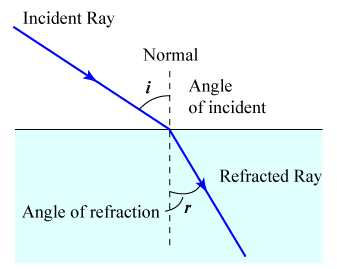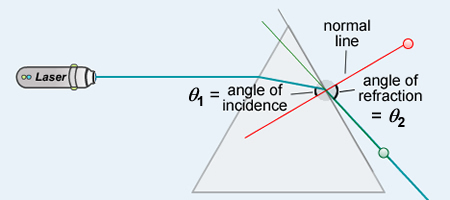Refraction
Claimed by the40
Refraction of EM waves
The Main Idea
Light passes through different materials, or mediums, at different speeds. In general, the denser the medium, the slower light passes through it. As light changes speed as it passes through a medium, it also bends at an angle. The optical density of a material is how well it can transmit light.
The Math of Refraction
- The Index of Refraction: the ratio of the speed of light through a vacuum to the speed of light in the medium. Written as: [math]\displaystyle{ n=\frac{c}{v} }[/math], where
- c=speed of light in a vacuum
- v=speed of light in medium
Note that the index of refraction can never be less than one, since [math]\displaystyle{ \frac{c}{c}=1 }[/math].
- Snell's Law: size of the angle of refraction, or how much the light bends. Written as:[math]\displaystyle{ n_1\sin\theta_1=n_2\sin\theta_2 }[/math], where
- [math]\displaystyle{ n_1 }[/math]=index of refraction of medium 1
- [math]\displaystyle{ n_2 }[/math]=index of refraction of medium 2
- [math]\displaystyle{ \theta_1 }[/math]=angle of incidence
- [math]\displaystyle{ \theta_2 }[/math]=angle of refraction.
A Visual Model
Here we see how the ray strikes a different medium and bends.
Here we see that the index of refraction is different for different wavelengths of light, so a prism will disperse white light.
Examples
Simple
Simple light from eye travels through water and bends:
Can be solved very easily with Snell's Law.
Middling
Single beam refraction through a prism with a laser pointer:
Calculations through a prism can be done as shown in the diagram below:
Difficult
While pretty, it is very difficult to solve for all the angles and indices of refraction correctly! This is how it works:
Connectedness
One of the most common uses of refraction is, quite simply, glasses. The way that light bends around a curved lens and refracts magnifies the image and can give you better eyesight.
On this vein, refractor telescopes, used in astronomy are quite common as well, especially among amateur astronomers.
Fiber optics is entirely dependent upon refraction and total internal reflection. These cables can send information at speeds approaching the speed of light, since the information is carried in the light itself.
Atmospheric refraction is also the cause of green flashes.
History
Thomas Harriot was the first person to discover that light bends when travelling through a different medium. However, it was Willebrord Snell who rediscovered it and then have the law of refraction named after him. It was initially published by Descartes in 1637, although Harriot had discovered it at least 35 years prior to that date.
Refractive lens began to be used on telescopes by 1608 and were the first type of optical telescopes developed.
See also
External links
http://www-rohan.sdsu.edu/~aty/explain/optics/refr.html






